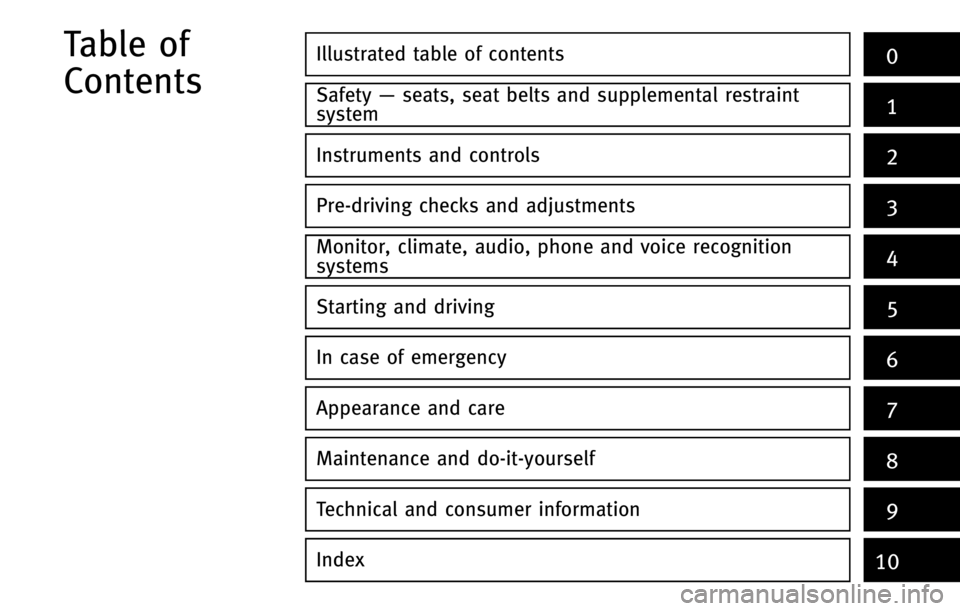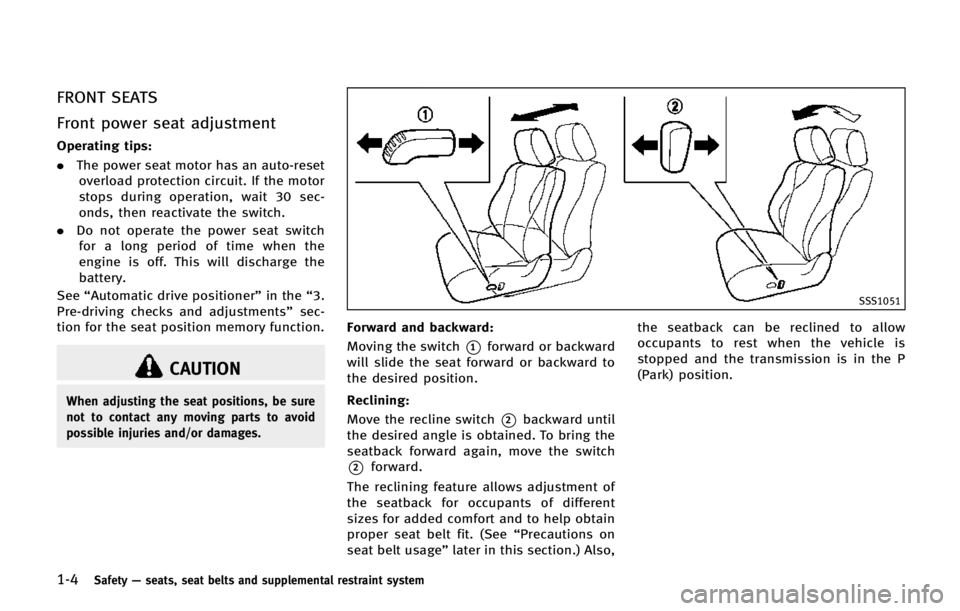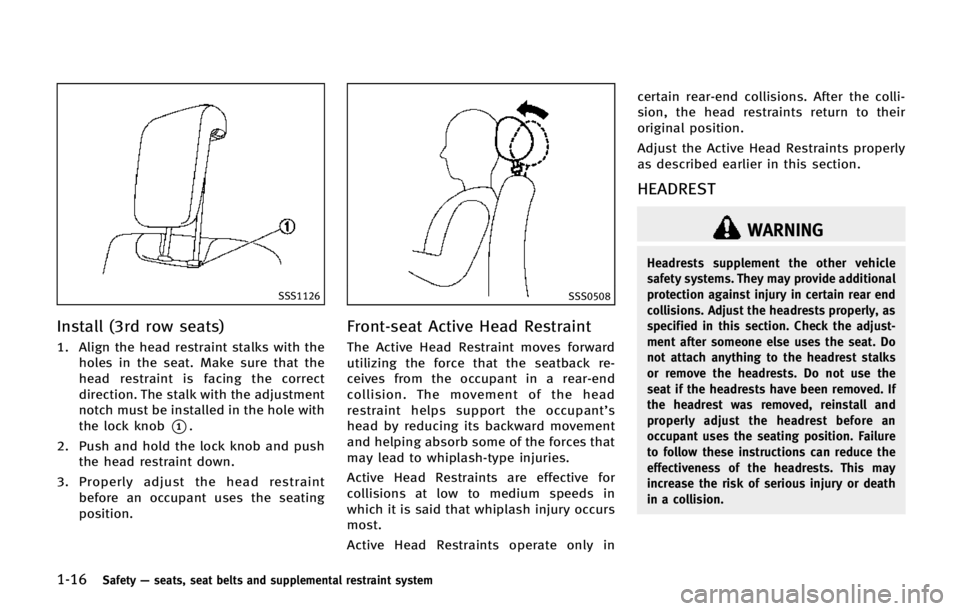seat adjustment INFINITI QX80 2014 Owner's Manual
[x] Cancel search | Manufacturer: INFINITI, Model Year: 2014, Model line: QX80, Model: INFINITI QX80 2014Pages: 578, PDF Size: 2.8 MB
Page 6 of 578

Illustrated table of contents0
Safety—seats, seat belts and supplemental restraint
system1
Instruments and controls
Pre-driving checks and adjustments
Monitor, climate, audio, phone and voice recognition
systems
Starting and driving
In case of emergency
Appearance and care
Maintenance and do-it-yourself
Technical and consumer information
Index
2
3
4
5
6
7
8
9
10
Table of
Contents
Page 24 of 578

SSS0133
WARNING
.Do not ride in a moving vehicle when the
seatback is reclined. This can be danger-
ous. The shoulder belt will not be
against your body. In an accident, you
could be thrown into it and receive neck
or other serious injuries. You could also
slide under the lap belt and receive
serious internal injuries.
. For the most effective protection when
the vehicle is in motion, the seat should
be upright. Always sit well back in the seat with both feet on the floor and
adjust the seat belt properly. See
“Pre-
cautions on seat belt usage” later in this
section.
. After adjustment, gently rock in the seat
to make sure it is securely locked.
. Do not leave children unattended inside
the vehicle. They could unknowingly
activate switches or controls. Unat-
tended children could become involved
in serious accidents.
. The seatback should not be reclined any
more than needed for comfort. Seat belts are most effective when the passenger
sits well back and straight up in the
seat. If the seatback is reclined, the risk
of sliding under the lap belt and being
injured is increased.
Safety
—seats, seat belts and supplemental restraint system1-3
SEATS
Page 25 of 578

1-4Safety—seats, seat belts and supplemental restraint system
FRONT SEATS
Front power seat adjustment
Operating tips:
. The power seat motor has an auto-reset
overload protection circuit. If the motor
stops during operation, wait 30 sec-
onds, then reactivate the switch.
. Do not operate the power seat switch
for a long period of time when the
engine is off. This will discharge the
battery.
See “Automatic drive positioner” in the“3.
Pre-driving checks and adjustments” sec-
tion for the seat position memory function.
CAUTION
When adjusting the seat positions, be sure
not to contact any moving parts to avoid
possible injuries and/or damages.
SSS1051
Forward and backward:
Moving the switch
*1forward or backward
will slide the seat forward or backward to
the desired position.
Reclining:
Move the recline switch
*2backward until
the desired angle is obtained. To bring the
seatback forward again, move the switch
*2forward.
The reclining feature allows adjustment of
the seatback for occupants of different
sizes for added comfort and to help obtain
proper seat belt fit. (See “Precautions on
seat belt usage ”later in this section.) Also, the seatback can be reclined to allow
occupants to rest when the vehicle is
stopped and the transmission is in the P
(Park) position.
Page 27 of 578

1-6Safety—seats, seat belts and supplemental restraint system
SSS1081
Captain ’s seat
SSS1065
Bench seat
Reclining
Pull the reclining lever*Aand position the
seatback at the desired angle. Release the
reclining lever after positioning the seat at
the desired angle.
To return the seatback, pull the lever.
The reclining feature allows adjustment of
the seatback for occupants of different
sizes to help obtain proper seat belt fit.
(See “Precautions on seat belt usage” later
in this section.) The seatback may also be
reclined to allow occupants to rest when
the vehicle is parked.
WARNING
. Do not ride in a moving vehicle when the
seatback is reclined. This can be danger-
ous. The shoulder belt will not be
against your body. In an accident, you
could be thrown into it and receive neck
or other serious injuries. You could also
slide under the lap belt and receive
serious internal injuries.
. For the most effective protection when
the vehicle is in motion, the seat should
be upright. Always sit well back in the
seat with both feet on the floor and adjust the seat belt properly. See
“Pre-
cautions on seat belt usage” later in this
section.
. After adjustment, check to be sure the
seat is securely locked.
Entry to 3rd row seat
CAUTION
.Do not drive with the 2nd row seat
tipped up.
. Be careful not to allow the 2nd row seat
to pinch, hit any part of your body or
other people when operating the 2nd
row seat. Make sure the seat path is
clear of all objects before moving the
seat.
The 2nd row seat can be tipped forward for
easy entry to or exit from the 3rd row seat.
Page 29 of 578

1-8Safety—seats, seat belts and supplemental restraint system
SSS1116
3RD ROW SEATS
The 3rd row power folding seat controls are
located behind the 2nd row seat (both the
driver’s and passenger’s side) on the 3rd
row cup holder console
*1. There are also
controls located on the rear quarter trim
panel behind the 3rd row seats (passen-
ger’s side)
*2.
Before operating the 3rd row seats:
. Make sure the 2nd row seatback is not
reclined.
. Lower the 3rd row head restraint to the
full down position. .
Disconnect and secure the center seat
belt and tongues into the retractor
base. See “3rd row center seat belt”
later in this section.
— Always reconnect the center seat
belt when the seat is returned to the
upright position
. Make sure that there are no objects on
the seatback cushion.
SSS1095
Power reclining
Push and hold the rear side of the switch
*1beside the 3rd row cup holders until
the desired seatback angle (up to 20
degrees) is obtained. To move the seatback
forward again, push and hold the front side
of the switch
*2until the desired angle is
obtained.
WARNING
. After adjustment, check to be sure the
seat is securely locked.
Page 31 of 578

1-10Safety—seats, seat belts and supplemental restraint system
tion. If they are not completely secured,
passengers may be injured in an acci-
dent or sudden stop.
. Properly secure all cargo to help prevent
it from sliding or shifting. Do not place
cargo higher than the seatbacks. In a
sudden stop or collision, unsecured
cargo could cause personal injury.
HEAD RESTRAINTS
WARNING
Head restraints supplement the other vehi-
cle safety systems. They may provide addi-
tional protection against injury in certain
rear end collisions. Adjust the head re-
straints properly, as specified in this sec-
tion. Check the adjustment after someone
else uses the seat. Do not attach anything
to the head restraint stalks or remove the
head restraint. Do not use the seat if the
head restraint has been removed. If the
head restraint was removed, reinstall and
properly adjust the head restraint before an
occupant uses the seating position. Failure
to follow these instructions can reduce the
effectiveness of the head restraints. This may increase the risk of serious injury or
death in a collision.
Page 33 of 578

1-12Safety—seats, seat belts and supplemental restraint system
Components
1. Head restraint
2. Adjustment notch (es)
3. Lock knob
4. Stalks
SSS0997
Adjustment (front seats and 2nd
row outboard seats)
Adjust the head restraint so the center is
level with the center of your ears.
SSS0993
To raise the head restraint, pull it up.
Page 35 of 578

1-14Safety—seats, seat belts and supplemental restraint system
SSS0996
Install (front seats and 2nd row
outboard seats)
1. Align the head restraint stalks with the
holes in the seat. Make sure that the
head restraint is facing the correct
direction. The stalk with the adjustment
notches
*1must be installed in the
hole with the lock knob
*2.
2. Push and hold the lock knob and push the head restraint down.
3. Properly adjust the head restraint before an occupant uses the seating
position.
CAUTION
Models with a head restraint display (if so
equipped) are designed so that the head
restraint cannot be removed. The head
restraint display may be damaged if the
head restraint is forcibly pulled out.
SSS1123
Adjustment (3rd row seats)
To raise the head restraint, pull it up to the
lock position.
Page 37 of 578

1-16Safety—seats, seat belts and supplemental restraint system
SSS1126
Install (3rd row seats)
1. Align the head restraint stalks with the
holes in the seat. Make sure that the
head restraint is facing the correct
direction. The stalk with the adjustment
notch must be installed in the hole with
the lock knob
*1.
2. Push and hold the lock knob and push the head restraint down.
3. Properly adjust the head restraint before an occupant uses the seating
position.
SSS0508
Front-seat Active Head Restraint
The Active Head Restraint moves forward
utilizing the force that the seatback re-
ceives from the occupant in a rear-end
collision. The movement of the head
restraint helps support the occupant’ s
head by reducing its backward movement
and helping absorb some of the forces that
may lead to whiplash-type injuries.
Active Head Restraints are effective for
collisions at low to medium speeds in
which it is said that whiplash injury occurs
most.
Active Head Restraints operate only in certain rear-end collisions. After the colli-
sion, the head restraints return to their
original position.
Adjust the Active Head Restraints properly
as described earlier in this section.
HEADREST
WARNING
Headrests supplement the other vehicle
safety systems. They may provide additional
protection against injury in certain rear end
collisions. Adjust the headrests properly, as
specified in this section. Check the adjust-
ment after someone else uses the seat. Do
not attach anything to the headrest stalks
or remove the headrests. Do not use the
seat if the headrests have been removed. If
the headrest was removed, reinstall and
properly adjust the headrest before an
occupant uses the seating position. Failure
to follow these instructions can reduce the
effectiveness of the headrests. This may
increase the risk of serious injury or death
in a collision.
Page 52 of 578

SSS0896
Shoulder belt height adjustment
(for front seats and 2nd row seats)
The shoulder belt anchor height should be
adjusted to the position best for you. (See
“Precautions on seat belt usage”earlier in
this section.)
To adjust, push the button
*A, and then
move the shoulder belt anchor to the
desired position, so that the belt passes
over the center of the shoulder. The belt
should be away from your face and neck,
but not falling off of your shoulder. Release
the adjustment button to lock the shoulder
belt anchor into position.
WARNING
. After adjustment, release the adjustment
button and try to move the shoulder belt
anchor up and down to make sure it is
securely fixed in position.
. The shoulder belt anchor height should
be adjusted to the position best for you.
Failure to do so may reduce the effec-
tiveness of the entire restraint system
and increase the chance or severity of
injury in an accident.
SEAT BELT EXTENDERS
If, because of body size or driving position,
it is not possible to properly fit the lap-
shoulder belt and fasten it, an extender
that is compatible with the installed seat
belts is available that can be purchased.
The extender adds approximately 8 in (200
mm) of length and may be used for either
the driver or front passenger seating
position. See an INFINITI retailer for assis-
tance with purchasing an extender if an
extender is required.
WARNING
.Only INFINITI seat belt extenders, made
by the same company which made the
original equipment seat belts, should be
used with the INFINITI seat belts.
. Adults and children who can use the
standard seat belt should not use an
extender. Such unnecessary use could
result in serious personal injury in the
event of an accident.
. Never use seat belt extenders to install
child restraints. If the child restraint is
not secured properly, the child could be
seriously injured in a collision or a
sudden stop.
SEAT BELT MAINTENANCE
.To clean the seat belt webbing, apply a
mild soap solution or any solution
recommended for cleaning upholstery
or carpets. Then, wipe with a cloth and
allow the seat belts to dry in the shade.
Do not allow the seat belts to retract
until they are completely dry.
. If dirt builds up in the shoulder belt
guide of the seat belt anchors, the seat
Safety —seats, seat belts and supplemental restraint system1-31